

Newsletter
Issue 53 February 2006


~~~ NEWSDESK ~~~
Table of contents
Newsdesk, and dates for your diary 2
Museum Update 3
From our Archive 6
Merton Abbey Mills update 7
Canals 10
Notes on A priory Revealed 12
Wm Morris Adoration Tapestry
(Excerpt from Anna Matyukhina) 15
Glimpses of the Past 3, 9
Visits to the Museum. Numbers have slackened off over the winter period, but have been consistently good for Sunday openings. Since Christmas we have had two School visits for return Textile Workshops from Lonesome Primary School in Mitcham.
Volunteers. At the recent Quarterly Lunch Meeting we were pleased to have twenty volunteers round the Museum table (although some actually had to stand, as the table won't seat 20!) Nicholas welcomed Carol Warren to the lunch. She is the new Vestry Hall Manager who has taken over from Maureen Willett, who has now retired after 35 years at the helm. Carol is a local lady living in Morden who actually worked in Liberty's at the Merton Abbey factory when she was a youngster. She has already had a guided tour round the Museum exhibits and shown great interest in all our activities.
We were also pleased to see Marguerite at our lunch, looking fit and well, and anxious to be of help to new volunteer Jacquie Tucker who is getting to grips with the archival work..
There was also good news of Eric Trim who has now been transferred to Roehampton hopefully to have prosthetic limbs fitted. He has promised to be at our next Lunch Meeting on his new legs!
Members' Events
PAST: Members and their guests enjoyed a very successful Christmas Party in the
Museum with our usual excellent refreshments provided by Mary Hart.
FUTURE: Events in the pipeline for the spring/summer include visits to Ham House and the Carshalton Water Tower. More details in the next Newsletter.
We hope to have our usual stalls at the National Trust Fayre April 29th-May 1st.
The Wimbledon Village Fair takes place on Saturday June 24th.
Dates for your Diary
- Opening of new WIM Exhibition on Merton Priory Saturday 17th June.
- Wandle Valley Festival Sunday 18th June.
Subscriptions for the year 2005-6 are now due. A big thank you to all those who already paid. A reminder slip for those who haven't yet paid is enclosed.

From A Little Book of Old Rhymes - harsh words from harsher times!
Washing Days
They that wash on Monday
Have all the week to dry;
They that wash on Tuesday
Are not so much awry;
They that wash on Wednesday
Are not so much to blame;
They that wash on Thursday
Wash for shame.
They that wash on Friday
Wash in need;
They that wash on Saturday,
Oh, they're sluts indeed!

Sheila Harris February 2006
Museum Update
Meg Thomas reports that in December we were asked to supply some William Morris material to be photographed as part of an article in the February edition of Homes and Gardens. The article was about using natural dyes. Sadly the photos were not used but the museum was mentioned as a place to visit.
Eric Shaw and Carol Warren, the new Vestry Hall Manager are liaising over the new brown heritage signs which are to mark the museum’s existence, and the possibility of a permanent exterior sign on the Annexe so that the many people in the area who still say ‘I never knew you were there’ will have less excuse.
Criminal Record Board certificates are needed for the volunteers who deal with the school visits to the museum as well as outreach. The third anniversary of the first certificates is now up, and applications have been submitted for their renewal. Our thanks to LB Merton for their help in this.
Ravensbury/ HLF
We are still awaiting LB Merton’s approval of the documentation proposed by Heritage Lottery Fund which will enable us to start the next application process - apparently it is with their legal department at present. Hopefully more news next newsletter.
Slightly more promising is that Planning Enforcement are taking a more proactive role in persuading the freeholders to complete the works at Ravensburg Mill properly, and have written telling them that the lead lining was non negotiable.
Wandle Valley
There is a character Assessment consultation which has been got under way by Merton on its part of the Wandle Valley Conservation Area. We were not automatically on the consultation list, and by the time the documents were received it was too late for a reasoned response. However the work done by Merton on the documentation is impressive, and copies are in our library at the Museum.
Website
Thanks to Lone Levay’s prompt report we were able to react quickly when the site went down again, a couple of weeks ago. The reason was unexplained - the whole site had to be reloaded. Please could all of you let us know at any time if there are problems with the site. As Michael warned last time, now that he is no longer checking it on a daily basis, these problems will become more frequent, unless/until we can find a new Webb.
Serendipity
As previously reported, our members visit to the Red House last September coincided with the presentation to the national Trust of a recreated William Morris tapestry through the US society. Anna Matyukhina from St Petersburg’s Hermitage Museum was our guest on that occasion. It was amusing to see the winter Newsletter of the William Morris Society of America contains not only a lengthy report about the presentation, but also an article by Anna on one of the Hermitage’s own (original) William Morris tapestries.
And Finally
Last but not least, we were pleased to be invited to join the other three Merton Heritage groups at a reception in the Mayor’s Parlour in early December. As with all events with which she is concerned, the Mayor made sure that this was a really enjoyable affair, lasting much longer than is usual for such events, as well as being one of the rare occasions when we could exchange views with our colleagues in Merton Historical Society, the Wimbledon Society, and the Merton Heritage service.
Early copies of Lionel Green’s new book “A Priory Revealed” were also on show.
Nicholas Hart, February 2006
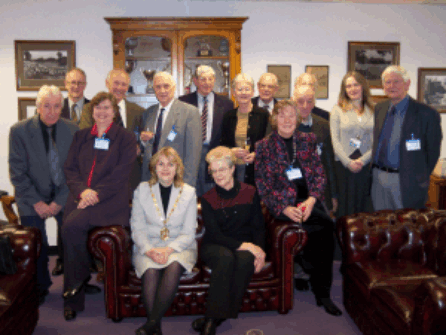 The Mayor of Merton, Cllr Judy Saunders, framed by representatives
of the Merton heritage groups
The Mayor of Merton, Cllr Judy Saunders, framed by representatives
of the Merton heritage groups
FROM OUR ARCHIVE - INTERVIEW WITH: Mr. W.F. Smith1983/4
Mr. Smith worked at Grove Mills. He started work in 1924 and earned approx 19 shillings a week. The firm was Hydraulic and Mechanical Engineering and Millwrights. Mr. Smith worked as an engineering machinist in the machine shop. His work involved repairing machinery. He went to firms to do repairs on the premises if possible. He worked on repairing and rebuilding many water wheels used in the various mills on the Wandle. Often the paddles needed replacing.
There were two wheels at Grove Mills, a large 6 horse power wheel, unused but in excellent condition when Mr. Smith joined the firm. The smaller wheel was used to drive the machinery for the firm Mitcham Fibre Mills.
Mitcham Fibre Mills produced fibres used for upholstering furniture. The fibres were manufactured from husks of coconuts. These were imported and brought by lorries to the Mill. The husks were fed into a crushing machine which broke them down to fibre hairs. The fibres were then turned into rope by a spinning machine. After this the rope was soaked in a mixture of soda, ash, and hot water, some was dyed black too. A teazing machine then separated the ropes into springy fibres. These were bagged up and sent to the upholstery firms. The fibres were used to stuff the furniture in the same way as horsehair.
During 1936/7 Mr. Smith rebuilt the water gate by the Mills which gave way and lowered the water level and pressure needed. A chute was built to take the water overhead whilst the gate was rebuilt.
In 1940 the firm left the mills and moved to Eveline Road where the firm made car components. Mr. Smith worked there until his recent retirement. He worked for the same firm all his life, for 56 years.
HOURS OF WORK:8 am-6pm - Mondays - Fridays
8 am -12 noon - Saturdays
Often had to work on Sundays or evenings when machinery broke down.
Working Conditions Rather primitive. Gas lamps for lighting which was very poor for engineering work. In the mill and machine shop the flooring was flag stones which were cold, damp and hard to keep clean. No proper heating. Mr Smith remembers open braziers being lit in really cold weather. Doesn't remember feeling cold. The ceilings were very low.
MERTON ABBEY MILLS UPDATE
In December the Wheelhouse at Merton Abbey Mills was visited by an officer of the British Library sound archive who was keen to record sounds of the mill wheel working. He stayed for quite a lot of the day, recording the wheel both in its slow mode and in its fast mode.
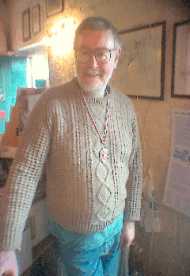 Steve Llewellyn, with one of the
medals awarded for the winning
float
Steve Llewellyn, with one of the
medals awarded for the winning
float
Apparently they needed the sound of a working mill wheel to illustrate a reading of the poems of A. E. Houseman. Houseman wrote a famous series of poems under the collective title of 'A Shropshire Lad' at the end of the 19th century and into the 20th century based on rural life. (We haven't managed to trace the actual poem that would require that background noise - any suggestions?)
On New Year's Day the Parade through central London featured a Merton float whose design was based on Merton Abbey Mills craft market and its working Wheelhouse.
Unfortunately, although the television stations around the world screened the parade we could find no live transmission on British television and only short excerpts in a news programme.
However, the Parade brought MAM to London’s attention when the float won first prize in the parade (for the competition between among the London Boroughs), including £6,000 to the mayor’s charity - the Merton Music Foundation. Well deserved medals commemorating the win have been awarded to all involved.
John Hawks’ more lyrical description of the float: “The float presented the industrial heritage via a delightfully lighthearted waterwheel made by Steve and Norman using broom handles, polycarbonate offcuts, a submersible pump and a genuine Victorian pulley wheel and axle rescued from a skip”.
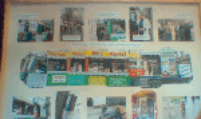 The photos of the float that can be
seen in the Wheelhouse
The photos of the float that can be
seen in the WheelhouseThe photograph with this article does scant justice to the float, but visitors to the Wheelhouse can see a large scale photo montage of the complete float. Unfortunately the float itself had to be dismantled immediately, so the flat bed truck so kindly donated for the occasion by SITA could be returned to its working life, and the photographic record is all that is left.
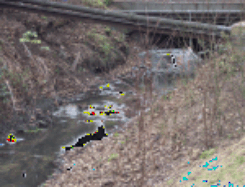 Bennetts Ditch, Feb 06, with full
complement of supermarket trolleys
Bennetts Ditch, Feb 06, with full
complement of supermarket trolleysThe Abbey Mills developement on the site is now substantially complete, but the need for an active site management program is all too obvious along Bennett’s Ditch. The flow is too slow and too shallow to clear itself, and relatively minor blockages cause stagnation. If the water smells in February, what will it be like in July?
So far as the future of the market is concerned, John Hawks has let us know the present position: He continues running the market for Merton Abbey Mills Ltd as part of the new structure. This is going reasonably well, and the market has had some good publicity to start the new year (triggered by the New Years Day parade, it featured in articles in local newspapers every week for the 6 weeks since Christmas). Terry Buckland of Office Estates Ltd, a subsidiary of the owner London and Argyll Estates Ltd, is running the estate overall, and has lots of new plans to renovate the existing buildings, create and promote Merton Abbey Mills, and to integrate more with neighbouring organisations (Savacentre, Premier Travel Inn, etc.) especially with a view to maximizing the parking opportunities.
 The priory wall in Station
Road
The priory wall in Station
RoadAlthough not strictly a Museum matter, we can't help noticing that the hotel building put up by Countryside at Merton Abbey Mills features constantly in the lists being compiled of Merton's worst buildings. Hopefully the extension of Sub area 3 of the Wandle Valley Conservation Area Character assessment to include Bennetts Ditch will ensure that it is demolished sooner rather than later, and insistence on a more appropriate design of building included in any future planning permission. That extension is not guaranteed, so any readers who agree should write in to Merton Council adding their support. For us at the museum, the Bennett Ditch extension gives some protection for the future of the Priory site now it has been proved to extend to the ditch, through the Priory’s ancillary buildings which made the site part of our industrial, as well as monastic, heritage.
Whilst on the subject of the Priory, renovation of the remains of the old flint Priory wall in Station Road has now been completed. They look a bit strange, but at least now are protected properly.
More worryingly, work has started on the Savacentre petrol station, whose construction irreparably damaged elements of the Priory that had not then been excavated. It is to be hoped the work will be controlled better this time.
A glimpse of the past
Between Streatham and Wimbledon London strides out in patches. It has not yet taken in Mitcham, which has a fine green with memories of great Surrey cricket and which grows all manner of scented flowers, lavender and mint and rosemary and everything old-fashioned for herbalists and perfumers and ladies' sachets and linen-chests. But Merton, north-west towards Wimbledon, has been caught fast. Merton church, in which Nelson used to worship, and which has his hatchment on the wall, under fine cross beams of oak, stands among brand new roofs and roads. Opposite the church is a forlorn relic. A fenced line of shrubs stands between the entrance to the churchyard and a blocked gap in an old wall. Examination will discover on the side nearest the church the stone threshold of a gateway. The gateway once led to a house which was Sheridan's, and which later became a calico warehouse. Sheridan is now only a memory: calico-printing remains. Francis Nixon, founder of the industry, lies in the churchyard.
From 'North Surrey' by Eric Parker 1937
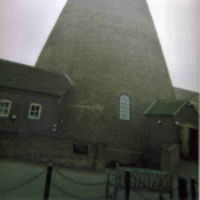 Red House Glass Cone,
Stourbridge Canal
Red House Glass Cone,
Stourbridge CanalCANALS
(photos by Meg Thomas 2005)
Now you may wonder what canals have to do with our museum, well it is perhaps a tenuous link but the River Wandle was nearly sacrificed to a canal and canals are part of the industrial history of this country.
To deal with the first link, at the beginning of the 19th century the building of a canal from London to Portsmouth was suggested, the mill owners of the time protested and an alternative solution was found, the Surrey Iron Railway.
Secondly the Wandle was the power source for mills allowing them to produce goods, and canals were the pathways for transporting goods and raw materials, not I hasten to add the goods produced by Wandle mills.
The building of the canals in the eighteenth and early nineteenth centuries was a key stage in the expansion of the industries in the midlands and north of England, for they made the transport of raw materials and finished goods possible in a time when roads were not suitable for heavy carts and the railways had not yet arrived.
A pack horse could carry about 300 pounds but the same horse could pull a barge loaded with 50 tons!
Serious canal building began during the first half of the 18th century. The first canals were wide canals similar in size to the rivers already being used, but the cost of building these wide canals proved too much and so narrower canals were built. These narrow canals were cheaper to build and the volume of water needed was less. This also resulted in the birth of the narrow boat.
But as trade increased the volume of traffic increased and more canals were needed. There had been an economic depression in the early 1780s, but as trade improved many people began to look for ways of investing their money. Canals had proved lucrative in the early years and so seemed to be an ideal investment.
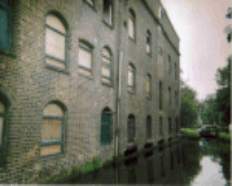 Disused Factory on the Birmingham and
Worcester Canal
Disused Factory on the Birmingham and
Worcester Canal
Canal Mania had arrived, but these speculators who were not involved with the industries failed to appreciate the connection between canals and factories, and so assumed canals would make money wherever they were. Canals were built through agricultural areas and meandered through the land taking the easiest route. Wonderful for today's holiday boaters but not practical when goods were needed to keep the factories working. Most of these canals made very little, if any, profit.
At the beginning of the 19th century several short canals were built to by-pass some of the more winding lengths and so reduce the journey time. These canals, of course, were built with the industries in mind.
Canal building came to an end in the mid 19th century, the age of the railways had arrived. The canals continued to be used even on into the 20th century but the railways and then the roads took over.
Travelling along the canals now they are so much part of the countryside it seems incredible that they were created with picks and shovels wielded by ‘navigators’ (navvies) mainly from Ireland.
In the next article I will return to my first thoughts on how the land along the canals is being developed for residential and recreational use.
Meg Thomas, February 2006
NOTES on ‘A Priory Revealed’
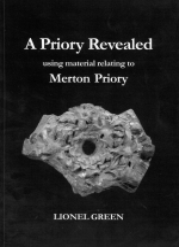 © Merton Historical Society
2005
© Merton Historical Society
2005the new publication by Lionel Green, chairman of Merton Historical Society. Michael Hart writes:
The definitive guide to the subject, A Priory Revealed published by the Museum of London Archeology Service is the spearhead title in the present campaign to provide a higher profile of the Merton Abbey conservation area, including the latest archaeological research.
A Priory Revealed updates the two earlier booklets which were more about how the site was arranged and what was produced. This will be the single most important work on subject of the Merton Priory for the general public, as it summarises the history of the priory, as, despite containing an enormous amount of historical information, it has been devised as general reading, rather than as a reference work for architectural historians, (a task better left to the full report being published at the end of the year by the Museum of London which will capture academics but fail to attract general readers).
Lionel’s book highlights the work being done by several groups including the Priory Trust, Merton Historical Society, English Heritage and the Museum of London. If I have one major quarrel, I would have had a better experience if the text was not so condensed.
This is by no means a condensed book, but it is meant to attract anyone interested in an absorbing historical narrative of the priory. The editors worked to make the writing accessible, including the key guidelines for researchers, and everything is well illustrated, yet this is no handbook for beginners, as the author asserts a level of authority in his documentary and archaeological evidence.
This book is the product of investigation by Lionel over many years to explore the religious, political and industrial development from the foundation of the Priory as an Augustinian monastery, occupying the site situated close to the present day
Recycling of the raw materials used to build the Merton priory
Merton Priory is indirectly responsible for the area's name, despite never being an abbey, but the institution is certainly responsible for providing construction materiels for subsequent generations, like the various churches that fell once their clerical powers were lost
Industries have flourished along the banks of the River Wandle for centuries, many of these used salvaged & natural materials found in the area, such as some future race will build upon our ruins! This was true of the Catholic church who have built upon the foundations of the aristocracy of the Roman Empire and the Merton Abbey Mills site.
When Henry VIII dissolved the nunnery at St Helen's Bishopsgate there was no great disarray as with other religious house closures like Merton Priory, the land and property of the church, gradually added upon over the centuries, was confiscated by the crown to help fund the hundred years war, the canons finally surrendered and the four-hundred year old Priory site was subsequently demolished during the reformation in 1538.
Some buildings like the Chapter house including remnants from the medieval period along with most of the foundations have survived. The waste and rubbish discovered under the old gardens and houses when the site was excavated 360 years later revealed a great deal information about people’s everyday lives, but the Tudor demolition gangs took most of the archaeology for recycling including 3,600 tons of stone. A masterpiece of destruction for both the Cuddington Church and Merton Priory that were demolished to make room for and build Henry VIII’s opulent new palace at Nonsuch near Sutton.
The tower bells and window lead were taken to the foundries and cast into cannon & shot for the coastal defences. Stone originally from the medieval Priory was also used in the later sections of the perimeter wall.
Merton Abbey Mills complex, up until it was surrendered to the crown and subsequently demolished during the Reformation 400 years later.
From the museum’s point of view, the industrial history titbits in the book are of most immediate importance, of which the recycling theme is reflected in the text boxes alongside this article.
It is worth noting that, for us as a Museum wishing to promote its 900th anniversary, the chronology of the Priory creates a problem. Merton Priory as an institution was founded in 1114, but there is a second date for the foundation of the priory building itself.
The order built its first church in Merton, situated near the present St. Mary’s Church in Merton Park, dating back to 1114. The area was abandoned by the canons (before being demolished in 1540) when they moved from their timber buildings, taking some with them, to the riverside site of the first flint and stone church, built in part upon the old Roman road, and consecrated in 1117 and it is this site which continued to grow.
The Priory site was fully integrated with the River Wandle, the course of which was changed where needed. Its tributaries supplied not only drinking water, and motive power but provided an effective sanitation system for the domestic buildings associated with the Priory.
If we are to promote the 900th anniversary, and start work towards it, then we must decide if it is the building we are celebrating, in which case 1117 would be the more correct initial date in terms of the excavated site, however this would mean planning an event in 12 years time.
All things being equal, taking 1114 as the start date would be a better idea as we would be planning for an event in 8 years, only 2 years after the 2012 Olympics.
This would also give us a second bite of the cherry in 2017, by which time it is possible that the interest stirred up by the first date will have produced more information to celebrate.
From the museum’s point of view, the industrial history titbits in the book are of most immediate interest, of which the recycling theme as reflected in the text box alongside this article add new insight.
Michael Hart, February 2006
“A Priory Revealed using material relating to Merton Priory”, by Lionel Green, ISBN 1 903899 52 4, may be obtained from Merton Historical Society at £7-50, plus £1 p&p. Telephone orders to Peter Hopkins 020 8543-8471.
We hope to be stocking this at the Museum soon.
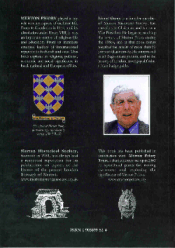 © Merton Historical Society
2005
© Merton Historical Society
2005
THE HERMITAGE 'ADORATION' TAPESTRY
By Anna Matyukhina Hermitage Museum, St. Petersburg (Extract)
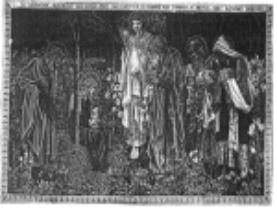 The Morris & Co 'Adoration' tapestry In the
Hermitage Museum 's collection. It was made to a
design bv Edward Burne-Jones and completed in
1902 for S. 1. Schyukin. Photograph Anna
Matyukhina.
The Morris & Co 'Adoration' tapestry In the
Hermitage Museum 's collection. It was made to a
design bv Edward Burne-Jones and completed in
1902 for S. 1. Schyukin. Photograph Anna
Matyukhina.
Among recent important events at the State Hermitage Museum in St. Petersburg, Russia, was the opening of the new permanent exposition on 'Art Nouveau' in May, 2005. One of the most vital and significant things about this exhibition was that the celebrated 'Adoration of the Magi' -the sole Merton Abbey tapestry in Russia, and moreover in the territory of the ex-Soviet Union -was placed on display in the museum.
The seventh tapestry made according to Burne-Jones's design for this subject, first used in Exeter College, Oxford, the Hermitage 'Adoration' tapestry was woven by Morris and Co. in 1902 for the famous Russian collector and patron of art, S. I. Schyukin. Since this design turned out to be the Firm's most popular, ten copies of'The Adoration' in all were woven at Merton from 1890 to 1907, and Morris himself regarded it as one of the Firm's most important works. After the October Revolution in 1917, the 'Adoration' of the Schyukin collection entered the State Museum of Modern Western Art, and from this was transferred to the State Hermitage Museum in 1949.
It is generally known that William Morris's 'bright dream' was the revival of the noble art of tapestry weaving and the tapestries of the so-called 'Golden Age' became the source of inspiration for him. Thus it is worth mentioning that there is another tapestry in the Hermitage collection representing the same subject, also titled The Adoration', part of a longer series on 'The Story of Christ and the Virgin Mary', which was woven in the beginning of the sixteenth century and thus embodies some of the craft which Merton Abbey tapestries were meant to revive.
...........................
Reproduced with kind permission of Anna. The complete article is in our Library.
The Vestry Hall Annexe, London Road, Mitcham, Surrey CR4 3UD
Tel: 020-8648-0127
~~~~~~~~~~
OPEN: Every Wednesday 1 ~ 4 pm;
First Sunday of each month 2 ~ 5 pm.
~~~~~~~~~~
The Museum is also open to schools and groups by appointment.
~~~~~~~~~~
Admission: Adults 50p, Children & Senior Citizens 20p
The Wandle Industrial Museum would like to point out that the views of contributors to this newsletter are not necessarily the views of the Museum. We would be happy to give the right to reply to anyone who finds the content contentious.

